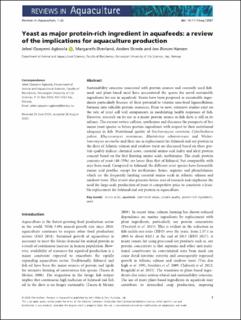| dc.description.abstract | Sustainability concerns associated with protein sources and currently used fishmeal and plant-based meal have necessitated the quests for novel sustainable ingredients for use in aquafeeds. Yeasts have been proposed as sustainable ingredients particularly because of their potential to valorise non-food lignocellulosic biomass into valuable protein resources. Prior to now, extensive studies exist on the role of yeast cell wall components in modulating health responses of fish. However, research on its use as a major protein source in fish diets is still in its infancy. The current review collates, synthesises and discusses the prospects of five major yeast species as future protein ingredients with respect to their nutritional adequacy in fish. Nutritional quality of Saccharomyces cerevisiae, Cyberlindnera jadinii, Kluyveromyces marxianus, Blastobotrys adeninivorans and Wickerhamomyces anomalus and their use as replacement for fishmeal and soy protein in the diets of Atlantic salmon and rainbow trout are discussed based on three protein quality indices: chemical score, essential amino acid index and ideal protein concept based on the first limiting amino acids, methionine. The crude protein contents of yeast (40–55%) are lower than that of fishmeal, but comparable with soya bean meal. Compared to fishmeal, the different yeast species have favourable amino acid profiles, except for methionine, lysine, arginine and phenylalanine which are the frequently limiting essential amino acids in Atlantic salmon and rainbow trout. This review also presents future area of research and emphasise the need for large-scale production of yeast at competitive price to constitute a feasible replacement for fishmeal and soy protein in aquaculture. | en_US |

